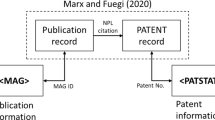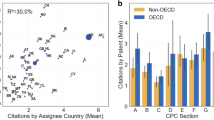Abstract
Scientific and other non-patent references (NPRs) in patents are important tools to analyze interactions between science and technology. This paper organizes a database with 514,894 USPTO patents granted globally in 1974, 1982, 1990, 1998 and 2006. There are 165,762 patents with at least one reference to science and engineering (S&E) literature, from a total of 1,375,503 references. Through a lexical analysis, 71.1% of this S&E literature is classified by S&E fields. These data serve as the basis for the elaboration of global and national 3-dimensional matrices (technological domains, S&E fields and number of references). Three indicators are proposed to analyze these matrices, allowing us to identify patterns of structured growth that differentiate developed and non-developed countries. This differentiation informs suggestions for public policies for development, emphasizing the need for an articulation between the industrial and technological dimension and scientific side. The intertwinement of these two dimensions is a key component of developmental policies for the twenty-first century.




Similar content being viewed by others
Notes
If we go further in the investigation of the papers cited in these two patents, we can reach, in the first, example Isaac I. Rabi’s 1938 paper that described magnetic resonance as a new scientific phenomenon and, in the second example, the Watson and Crick work on DNA structure. But this is a subject for another investigation.
As an example of this referencing scheme, for the ISI-discipline Biotechnology (number 16), the key words were Biotechnology, Biochemistry, Molecular Biology, Biomedical, Genetic, Heredity, Biophy, Bioch.
In 1974 Information Technology ranked in 23rd position, Telecommunications in 13th, Semiconductors in 25th, and Audiovisual in 21st. In 2006 these technological domains jumped to 1st, 2nd, 5th and 8th positions, respectively.
Between 1974 and 2006, biotechnology moved upward from the last position (30th) to the 23rd, pharmaceuticals from the 29th to 20th and medical engineering from the 22nd to the 17th.
“Research medicine” was ranked 18th in 1974 and jumped to the 6th position in 2006, “immunology” jumped from 22nd to 11th and “biotechnology” from 17th to 9th, and “general biology” from 14th to 10th.
A comparison with other research tools: comparison between the Matrix for the USA in 2006 and a Matrix built upon Cohen et al. (2002, p. 11): the Matrix from Cohen et al. would have an MFI equal to 94.9%. A comparison between the Matrix for Brazil 2006 and a Matrix built upon Rapini (2007): if Rapini had produced a Matrix, its MFI would be 17.7%. These observations show how these matrices of science and technology interactions are coherent with other research tools and get impressive similar results. This coherence strengthens the usefulness of this research tool, especially because these matrices allow an inter-country comparability that no other research tool has obtained, at least to date.
Of course, according to editorial norms regarding manuscript size, it is not possible to show all these matrices here. However, these matrices are available to the interested reader on request.
In this case, the correlation between the matrices from China and the United States for 2006 is relevant: in 2006 this correlation was high: 0.75.
References
Bassecoulard, E., & Zitt, M. (2004). Patents and publications: The lexical connection. In H. Moed, W. Glänzel, & U. Schmoch (Eds.), Handbook of quantitative science and technology research: The use of publication and patent statistics in studies of S&T systems (pp. 665–694). Dordrecht: Kluwer Academic Publishers.
Bernardes, A. T., & Albuquerque, E. M. (2003). Cross-over, thresholds, and interactions between science and technology: Lessons for less-developed countries. Research Policy, 32(5), 865–885.
Bhattacharya, S., & Meyer, M. (2003). Large firms and the science-technology interface: Patent, patent citations, and scientific output of multinational corporations in thin films. Scientometrics, 58(2), 265–279.
Braun, T., Glanzel, W., & Grupp, H. (1996). The weight of 50 nations in 27 science areas, 1989–1993 (part I). Scientometrics, 33(3), 263–293.
Callaert, J., van Looy, B., Verbeek, A., Debackere, K., & Thus, B. (2006). Traces of prior art: An analysis of non-patent references found in patent documents. Scientometrics, 69(1), 3–20.
Cohen, W., Nelson, R., & Walsh, J. (2002). Links and impacts: The influence of public R&D on industrial research. Management Science, 48(1), 1–23.
Colyvas, J., Crow, M., Gelijns, A., Mazzoleni, R., Nelson, R., Rosenberg, N., et al. (2002). How do university inventions get into practice? Management Science, 48(1), 61–72.
Freeman, C. (1994). The economics of technical change: Critical survey. Cambridge Journal of Economics, 18, 463–514.
Freeman, C. (1995). The “National System of Innovation” in historical perspective. Cambridge Journal of Economics, 19(1), 5–24.
Freeman, C., & Soete, L. (1997). The economis of industrial innovation. London: Pinter.
Guan, J., & He, Y. (2007). Patent-bibliometric analysis on the Chinese science-technology linkages. Scientometrics, 72(3), 403–425.
Klevorick, A., Levin, R., Nelson, R., & Winter, S. (1995). On the sources and significance of inter-industry differences in technological opportunities. Research Policy, 24, 185–205.
Lundvall. (1992). National System of Innovation. London: Pinter Publications.
Mazzoleni, R., & Nelson, R. (2007). The roles of research at universities and public labs in economic catch-up. Research Policy, 36(10), 1512–1528.
Mowery, D., & Sampat, B. (2005). Universities in national innovation systems. In J. Fagerberg, D. Mowery, & R. Nelson (Eds.), The Oxford handbook of innovation. Oxford: Oxford University Press.
Narin, F., Hamilton, K. S., & Olivastro, D. (1997). The increasing linkage between U.S. technology and public science. Research Policy, 26(3), 317–330.
Narin, F., & Noma, E. (1985). Is technology becoming science? Scientometrics, 7(3–6), 369–381.
National Science Board. (2002). Science and engineering indicators 2002 (http://www.nsf.gov/statistics/seind02/).
National Science Board. (2004). Science and engineering indicators 2004 (http://www.nsf.gov/statistics/seind04/).
National Science Board. (2006). Science and engineering indicators 2006 (http://www.nsf.gov/statistics/seind06/).
Nelson, R. (1988). Institutions supporting technical change in the United States. In G. Dosi, C. Freeman, R. Nelson, G. Silverberg, & L. Soete (Eds.), Technical change and economic theory (pp. 312–329). London: Pinter.
Observatoire des Sciences et des Techniques. (2006). Science & technologie: indicateurs 2006. Paris: Economica (http://www.obs-ost.fr/le-savoir-faire/etudes-en-ligne/etudes-2006/rapport-2006.html).
Rapini, M. (2007). Interação Universidade-Empresa no Brasil: Evidências do Diretório dos Grupos de Pesquisa do CNPq. Estudos Econômicos, 37(1), 212–233.
Ribeiro, L. C., Ruiz, R. M., Albuquerque, E. M., & Bernardes, A. T. (2006a). National systems of innovation and technological differentiation: A multi-country model. International Journal of Modern Physics C, 17(2), 247–257.
Ribeiro, L. C., Ruiz, R. M., Bernardes, A. T., & Albuquerque, E. M. (2006b). Science in the developing world: Running twice as fast? Computing in Science and Engineering, 8, 81–87.
Rosenberg, N. (1976). Perspectives on technology. Cambridge: Cambridge University.
Rosenberg, N. (1982). Inside the black box: Technology and economics. Cambridge: Cambridge University.
Schmoch, U. (1997). Indicators and the relations between science and technology. Scientometrics, 38(1), 103–116.
Tijsen, R. (2004). Measuring and evaluating science-technology connections and interactions. In H. Moed, W. Glänzel, & U. Schmoch (Eds.), Handbook of quantitative science and technology research: The use of publication and patent statistics in studies of S&T systems (pp. 695–715). Dordrecht: Kluwer Academic Publishers.
Tijssen, R. J., Buter, R. K., & van Leeuwen, N. (2000). Technological relevance of science: An assessment of citation linkages between patents and research papers. Scientometrics, 47(2), 389–412.
USPTO. Site: http://www.uspto.gov.
Verbeek, A., Callaert, J., Andries, P., Ebackere, K., Luwel, M., & Veugelers, R. (2002). Science and technology interplay—A modelling approach on a regional level. Final Report to the EC DG Research, Brussels.
Verbeek, A., Debackere, K., & Luwel, M. (2003). Science cited in patents: A geographic “flow” analysis of bibliographic citation patterns in patents. Scientometrics, 58(2), 241–263.
Zitt, M., Ramanana-Rahary, S., Bassecoulard, E., & Laville, F. (2003). Potential science-technology spillovers in regions: An insight on geographic co-location of knowledge activities in the EU. Scientometrics, 57(2), 295–320.
Acknowledgements
CNPq, Fapemig (Brazil), and the IDRC (Canada) partially supported this work. We would like to thank the anonymous referees and Scientometrics’ Editor in Chief, Tibor Braun, for their criticisms and suggestions. Any remaining errors are ours.
Author information
Authors and Affiliations
Corresponding author
Electronic supplementary material
Below is the link to the electronic supplementary material.
Rights and permissions
About this article
Cite this article
Ribeiro, L.C., Ruiz, R.M., Bernardes, A.T. et al. Matrices of science and technology interactions and patterns of structured growth: implications for development. Scientometrics 83, 55–75 (2010). https://doi.org/10.1007/s11192-009-0020-3
Received:
Accepted:
Published:
Issue Date:
DOI: https://doi.org/10.1007/s11192-009-0020-3




